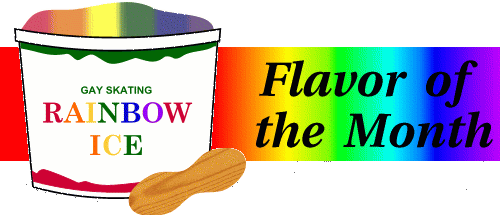

| Graphic by YIKES,Inc. |

Ask Christopher Nolan about his amateur competitive career, and he will laugh and say, "That was a million years ago! [Note: Rainbow Ice assures the public that Mr. Nolan is not that old.] My amateur career has NO bearing on who I am today. I've left that behind. Not that I'm not proud of it -- but that was a completely different lifetime."
Rest assured, though, that Nolan was a member of the Canadian national team, who trained primarily under Thom Hayim in Quebec before turning pro in 1988. Since then, he has specialized in what he calls "high-kicking his way out of the ensemble," using creativity and persistent hard work to make a name for himself in the pure-pro skating world.
American audiences will know him best as pro choreographer for his good friend Doug Mattis, who has been televised skating such Nolan creations as "The Imitation Number" and "Hypnotize." Nolan was also televised in Scott Hamilton's television special "Upside Down," performing double axels and flying change spins side-by-side with Hamilton.
One of his career highlights was performing in the second half of Toller Cranston's star-studded 1997 tribute show. Cranston had previously lauded Nolan, in his book Zero Tollerance, as one of skating's "great unknowns."
"I literally invited myself," said Nolan, whose coach Hayim grew up with Cranston. "I saw Toller one day at the Cricket Club and said, 'You can't have a show without me! I must be in it. I have a 4 1/2-minute number. I REFUSE to cut it down. I REFUSE to compromise my artistic integrity and edit it. It has to be seen in its ENTIRETY, or NOT AT ALL.'"
This attitude must have worked, because Nolan performed the number for Cranston and was told with a slight push of Cranston's left hand, "Very well, it's in."
Nolan stunned audiences as an ensemble skater for the 1999 Ice Theatre of New York annual show. Although he regularly lands double axels and the occasional surprise triple jump, for this show he concentrated on story-telling, rather than jumps and spins. Two notable pieces were "Transitions," in which he skated the role of the main character seeking balance in the five elements of his life (represented by other skaters), and "Tango Images," in which he partnered both women and men. Although Doug Webster skated with Nolan in both pieces, possibly giving the appearance of portraying a gay couple, Nolan said that was not necessarily the intent.
"Tango was born of two men dancing together," Nolan said. "There maybe had been a sexual energy that the audience was getting off of it, but it was mainly, 'Okay, let's remember the steps and not slice each other's legs open.' We were never meant to be in love with each other. The women would dance together as well; that's far more accepted. We performed it at Rockefeller Center and we were told there was an audible gasp when we danced together, but an audible 'oooh' when the two girls danced together. Figure that out."
Nolan hypothesized that male-male partnering makes more of an impact on skating audiences because of the way skating culture stresses male-female partnering. "It's all because of the way skating has been brought up: the boy and the girl, and the boy presents the girl. That's what we grew up with, and that's the only thing we ever saw on the ice. There's nothing else we were ever exposed to, ever ever ever. So people automatically freak out [when seeing same-sex partnering]. The dance community is different, because they've been doing it for so much longer."
Nolan also pointed out that the energy of performing is more significant than the gender of his partner. "It's a challenge for me to see how much I can get into the piece, portray what the choreographer wants," he said. "It's not like I'm gay, and now I'm pretending to be into this girl. It's not that complicated. The whole idea when you're performing is to use many different things to mold your performance."
Nolan has been out as gay since before he turned professional, and says "in the skating world, I've never hidden it." Although the Brian Orsers of the world might have reason to worry that being out will harm their careers, Nolan laughed at the notion that his pro career, which is different from an A-list Olympian like Orser's, could be affected by such a thing.
"They choose me because of my work, not because I'm a personality," he said. "In the real trenches of show skating, it's totally guys are out all over the place, all the producers know it, and they somewhat embrace it. They know I have a partner, Ian -- the most fabulous thing in my life right now -- and talk about it. I don't have to flip over the pictures or say that we're 'roommates.'"
Nolan's next engagement is the ice show at Knott's Berry Farm, which runs daily from June 19 through September 5 (except Wednesdays). Nolan will perform a country number "with a scary turquoise cowboy suit," and a jazz-rap piece by Quincy Jones, which was choreographed by Doug Mattis when Mattis skated in the show last year.
Nolan's career has been all about "the real trenches" of skating, from working with Willy Bietak (Ice Capades, Holiday on Ice), to choreographing for J.P. Martin's industrial skating shows in Montreal, to "dyeing my hair blond for a thousand screaming Mexican girls," as he described a recent stint. "It's still skating, and I still love it...I love it all," he said, "and nobody has as much fun skating as I do."